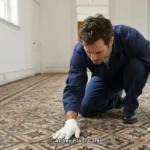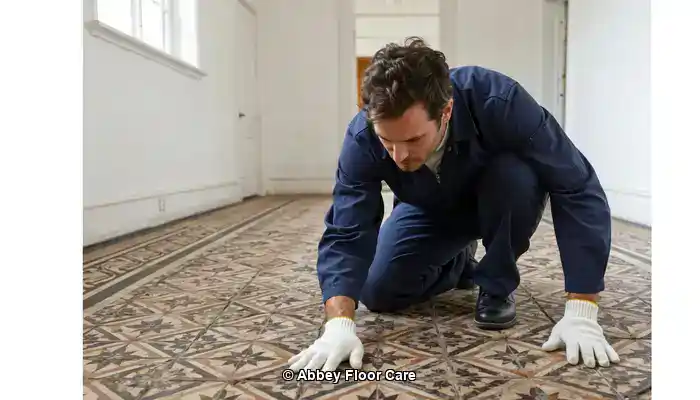
Last Updated on October 30, 2025 by David
Essential Highlights for Revitalizing the Vibrancy of Faded Victorian Mosaic Tiles
- Victorian mosaic tiles often experience colour loss due to ingrained dirt, aged coatings, and overall surface wear, a condition influenced not just by the passage of time but environmental factors too.
- Steering clear of harsh chemicals and aggressive scrubbing is vital, as these practices can strip the original pigments from encaustic and geometric tiles, leading to irreversible damage.
- Effective restoration begins with comprehensive cleaning using pH-neutral solutions and low-speed rotary machines equipped with soft brushes to ensure thorough dirt extraction.
- Carefully removing old sealers and waxes is crucial in revealing the true condition of the tile surface underneath.
- Enhancing colour can be achieved with breathable, stone-safe sealers that intensify hues without leaving a glossy residue, preserving the natural look.
- Professional restoration revives original pigments without resorting to repainting or artificial colouring, thereby maintaining the tiles’ historical authenticity.
- To sustain restored tiles, gentle cleaning routines are necessary, avoiding products containing acid or bleach to protect the surface.
- Heritage-sensitive methods are essential in preserving both the aesthetic and historical significance of the tiles.
The Significance of Revitalizing Victorian Tiles for Heritage Preservation

Abbey Floor Care restoring the colour to a Victorian clay tile floor using a colour-enhancing impregnating sealer.
Victorian encaustic and mosaic tiles are not just mere decorative items; they are crucial elements of British architectural heritage, celebrated for their intricate craftsmanship and distinctive colour palettes created from mineral pigments that are embedded within the clay tile bodies. The artistry and meticulous attention to detail found in these tiles reflect the cultural values and aesthetic preferences of the Victorian era, making their preservation essential for future generations to appreciate and admire.
Expert Recommendation: Optimal Products for Daily Maintenance of Victorian Tiles
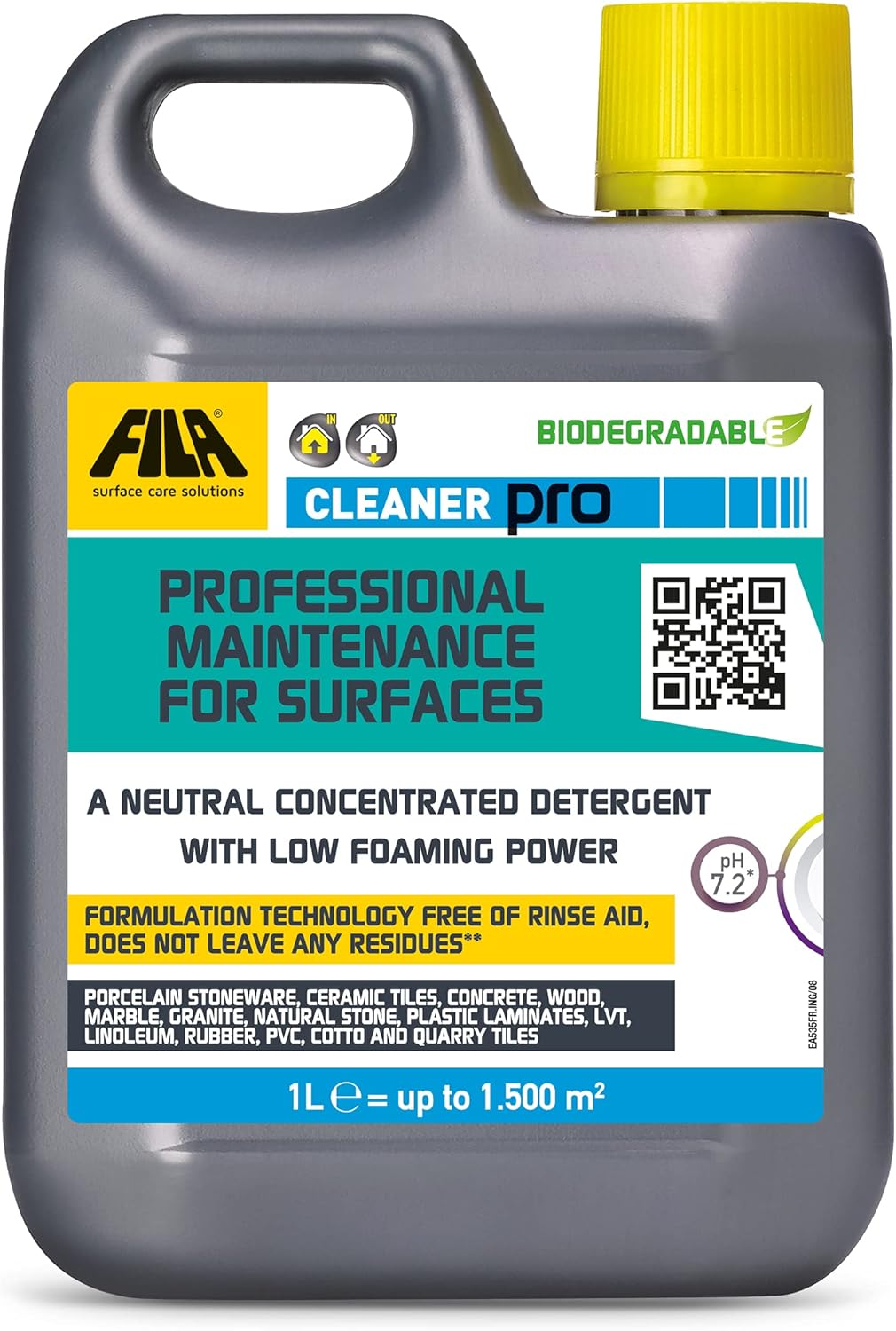
Fila Pro Floor Cleaner
|
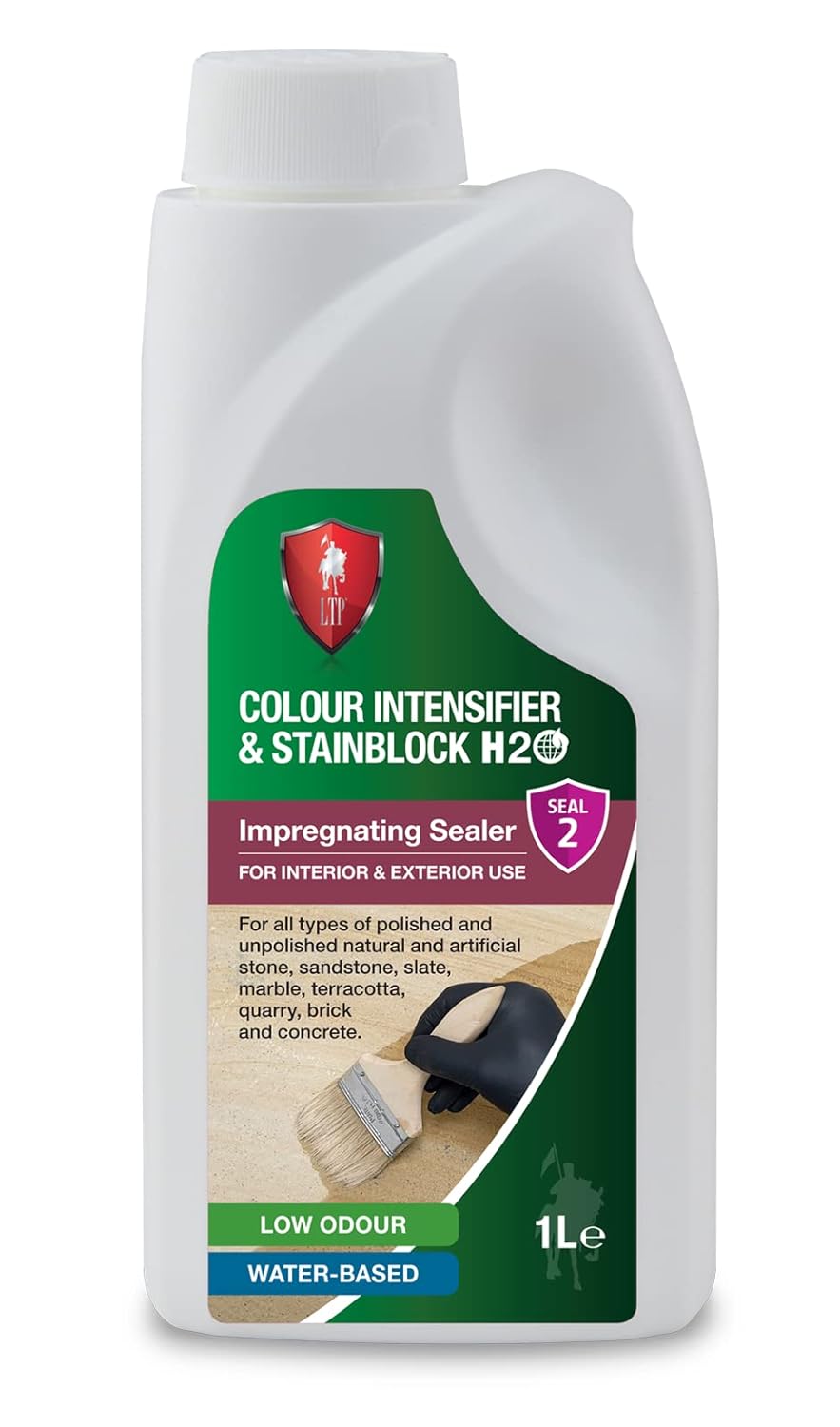
LTP Colour Intensifier & Stainblock H20
|
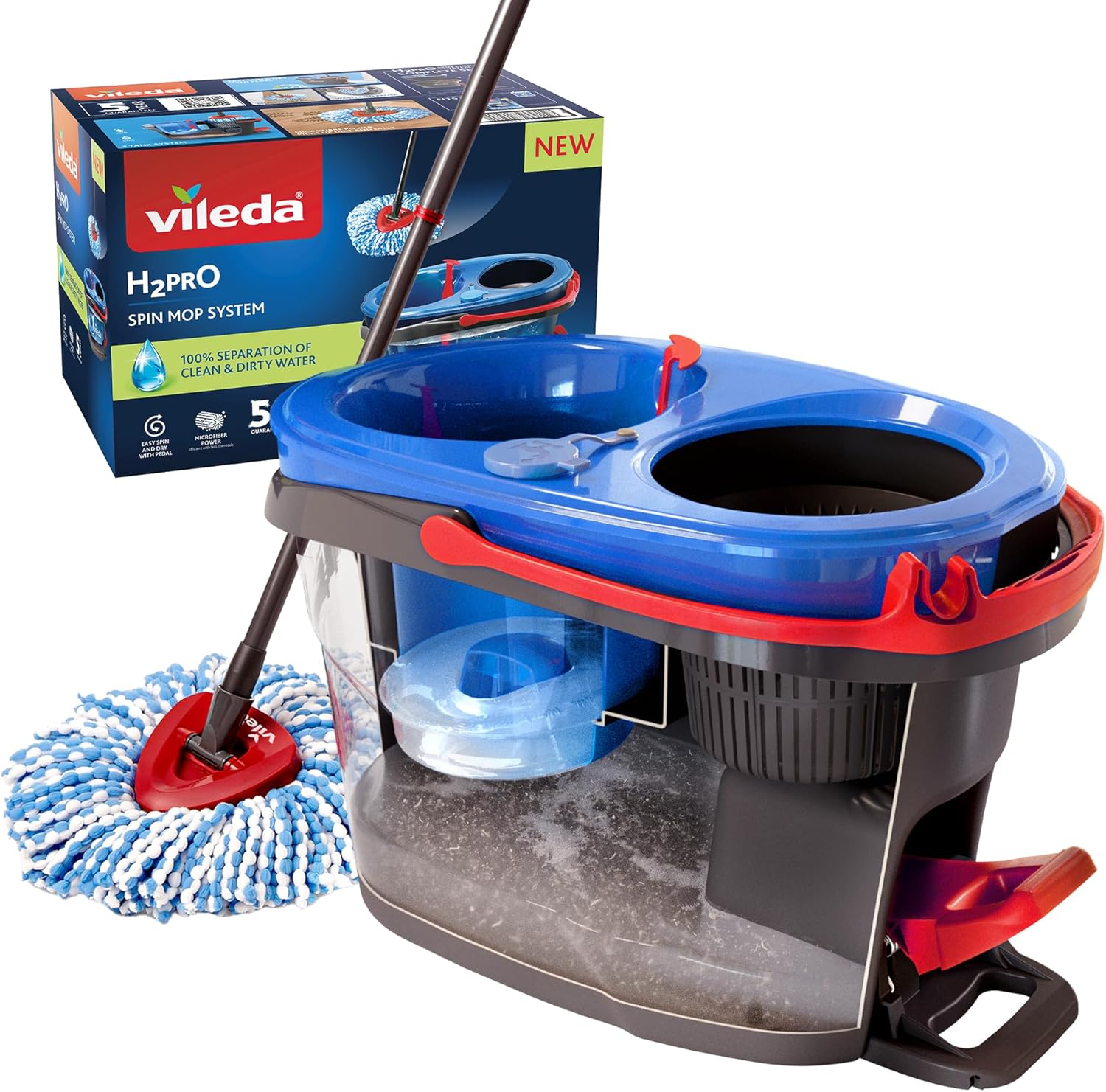
Vileda H2PrO Spin Mop System
|
However, as time progresses, the exquisite nature of these tiles may fade due to various factors like surface wear, chemical interactions, and environmental influences. The process of restoring their original vibrancy demands specialists who not only understand the materials but also employ historically accurate techniques and high-quality products. Hiring experienced professionals ensures that the restoration process respects the tiles’ integrity while enhancing their visual appeal and revitalizing their charm.
The Causes Behind Fading Victorian Mosaic Tiles and Surface Dulling Factors
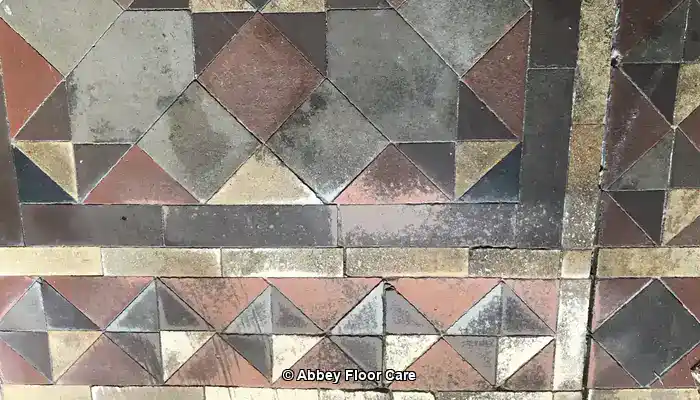
Example of Victorian Clay Tile Floor dulled through surface wear and damage.
While the pigments serve as a vital aspect of the tile’s composition, various factors contribute to the fading and dulling of these beautiful surfaces:
- Accumulated dirt and grime: Continuous foot traffic introduces fine particles and oils that infiltrate porous surfaces, scattering light and dulling vibrant colours over time.
- Wax and polish buildup: Layers of non-breathable wax or sealants trap moisture, leading to a cloudy or yellowed appearance as time progresses.
- Moisture-related issues: Many Victorian tiles were laid over subfloors that lack damp-proof membranes, resulting in rising damp that carries soluble salts. These salts crystallize on the tile surface as efflorescence, further obscuring the original tones and beauty.
- Physical abrasion: Fine scratches from years of wear disrupt the smooth reflection of light, reducing the overall visual richness and appeal of the tiles.
Effective restoration must address each of these contributing factors systematically while preserving the historic integrity of the tiles, ensuring they regain their former glory.
The Critical Role of Breathability When Damp-Proof Membranes Are Absent
Considering that many Victorian tiled floors are situated over older subfloors lacking a damp-proof membrane (DPM), it is essential for their natural clay structure to retain its permeability. This permeability is crucial as it allows moisture to evaporate from the subfloor. Non-breathable wax coatings or film-forming sealers obstruct this essential evaporation pathway, leading to moisture accumulation beneath the surface. This entrapment of salts and humidity can result in efflorescence, degradation of surface minerals, and the undesirable occurrence known as wax blooming—a whitish haze on the tiles. Restoration strategies must prioritize breathable impregnating sealers that protect the tiles while allowing moisture vapour to escape freely, thus preventing long-term damage and deterioration.
Detailed Insights into Pigments and Composition of Victorian Tiles
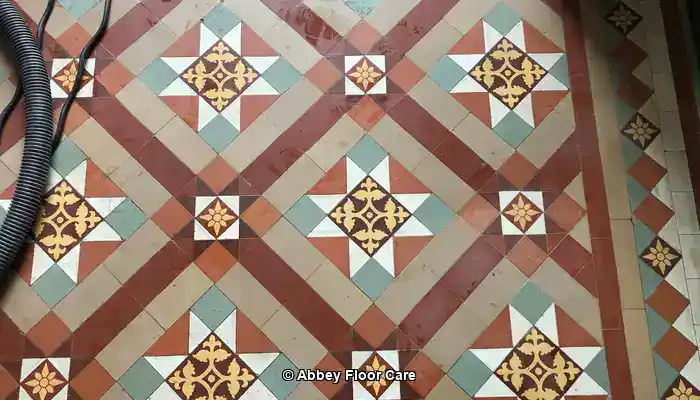
An example of different pigments in a Victorian Clay tile floor during restoration by Abbey Floor Care
Analyzing the Significance of Mineral Oxide Pigments in Victorian Tiles
Victorian mosaic and encaustic tiles derive their distinctive earthy colours from mineral oxide pigments that are embedded directly into the clay. These pigments not only enhance durability but also contribute to the depth and vibrancy of the colours. Commonly utilized pigments include:
- Iron oxide: responsible for terracotta reds, warm rust browns, and soft ochres.
- Manganese: yields deep browns and rich black tones, enhancing the tile’s character.
- Cobalt: introduces a spectrum of blue hues that add elegance.
- Chromium: produces natural green shades that complement the overall palette.
The Firing and Fusion Techniques in Tile Production
During the manufacturing phase, tiles undergo firing at temperatures of approximately 1100°C, a process that vitrifies the clay and fuses the pigments deep within the tile body. This technique guarantees that the colour is integral to the tile rather than merely a surface application, resulting in enduring vibrancy and visual allure.
Recognizing the Characteristics of Porous Unglazed Finishes in Victorian Tiles
Typically, Victorian tiles exhibit a porous, unglazed matte finish that enhances their natural aesthetic. However, this porosity makes the tiles absorbent and susceptible to surface contamination and moisture, necessitating meticulous cleaning and maintenance practices to preserve their condition and longevity effectively.
Understanding Variability in Colour Durability Across Different Tile Types
Natural earth pigments, especially in red and yellow tiles, often contain fewer mineral additives compared to their darker counterparts, such as black tiles, which commonly utilize manganese. This difference signifies that red and yellow tiles are generally less durable and more prone to surface dishing under heavy foot traffic. This wear manifests as shallow depressions where foot traffic is concentrated, resulting in uneven colour intensity and a gradual loss of surface flatness over time.
Key Considerations for Successful Restoration Practices
A comprehensive understanding of pigment composition and wear patterns is critical when planning a restoration. Softer-toned tiles require gentle cleaning methods and specifically formulated impregnating sealers that respect their physical properties while enhancing colour. Conversely, darker, more resilient tiles can endure more rigorous cleaning but still necessitate breathable, colour-enhancing protection to maintain their vibrancy and visual appeal for the long term.
Implementing Proven Cleaning Techniques for Victorian Mosaic Tiles
Achieving effective cleaning is imperative to restore Victorian encaustic and mosaic tiles to their original vibrancy. However, the cleaning process requires a specialized approach that goes beyond simply using pH-neutral detergents. Professional restorers utilize specifically formulated alkaline cleaners and mechanical techniques to effectively remove heavy soiling and old residues without compromising the historic integrity of the tiles.
Thoroughly Eliminating Debris and Loose Dirt
The cleaning process initiates with the removal of all loose dirt and grit, which can be accomplished using soft brushes or vacuuming with brush attachments. This initial step is pivotal in preventing scratches on the delicate tile surfaces during the following cleaning stages, ensuring that both the integrity and visual quality of the tiles are preserved throughout the entire process.
Leveraging Alkaline Cleaners for Deep Soil Extraction
Unlike pH-neutral cleaners, which often lack the necessary chemical strength to combat ingrained fatty acids and organic soils, alkaline cleaners are essential for thoroughly dissolving household oils, grease, and sticky residues that frequently adhere to tile surfaces and grout lines. These alkaline formulations effectively break down the binding agents of dirt, sugars, and fats, facilitating efficient removal while maintaining compatibility with the mineral structure of Victorian tiles.
Professional-grade alkaline products, such as PS87 PRO or custom formulations provided by heritage cleaning specialists, are typically utilized in diluted form. This approach ensures a profound clean without excessive aggression towards the clay body. It is critical to remember that, even with alkaline cleaners, caution is necessary, and spot testing is always recommended prior to full application to avoid potential damage.
Employing Mechanical Agitation with Appropriate Pads
Mechanical action significantly enhances cleaning efficiency. Low-speed rotary scrubbers fitted with red or, in certain cases, green non-abrasive pads are commonly utilized to agitate soils from small pits, tile surfaces, and grout lines. These pads effectively clean while preserving the integrity of tile edges and delicate surface details, making them indispensable tools in the restoration process.
Targeted Removal of Waxes and Inappropriate Sealants
Years of use often result in the buildup of old waxes and sealants, particularly from DIY attempts that employed unsuitable products. Water-based cleaners—whether alkaline or mildly acidic—are preferred for effectively eliminating these residues without damaging the mineral structure of the tiles. However, stubborn ‘exotic’ or solvent-resistant coatings may necessitate the use of targeted solvent-based removers such as Lithofin Wax-Off or LTP Solvex. These solvents effectively soften and emulsify waxes and old sealants but must be handled with care, requiring trained professionals for safe application and disposal methods.
Comprehensive Rinsing and Drying Protocols
Following chemical cleaning, meticulous rinsing is crucial to eliminate any cleaning residues. Multiple rinses with clean water, supplemented by wet vacuum extraction, ensure that no detergent or solvent remnants remain, which could impede subsequent restoration coatings. The drying time is contingent upon environmental factors, including humidity, surface type, and moisture levels. Restoration experts invariably utilize moisture meters to verify that the tiles are completely dry before applying any impregnating sealers or protective treatments. This thorough approach prevents moisture entrapment, which could lead to efflorescence, staining, or damage beneath sealed layers.
The Advantages of Comprehensive Cleaning
Thorough cleaning reveals the actual condition of the tiles by eliminating visual obstructions. This process exposes areas that may require repair and provides a clean, receptive surface for colour-enhancing impregnators or other restorative products. Such careful preparation is fundamental to the success and longevity of Victorian mosaic tile restoration, ensuring that the tiles can be enjoyed for many years to come.
Enhancing Colour with Premium Quality Impregnating Sealers
Restorers utilize impregnating colour-enhancing sealers manufactured by LTP and Lithofin, brands renowned for their advanced, heritage-approved formulations. Unlike superficial coatings, these sealers:
- Penetrate deeply into tile pores to enrich colour by altering light refraction.
- Maintain vapour permeability, which is essential for moisture escape—a critical factor in older floors lacking DPM layers.
- Provide durable protection against stains and foot traffic without compromising the natural texture or gloss of the tiles.
- Applied in multiple light coats, with each layer allowed to penetrate fully before the next is applied, ensuring uniformity in appearance.
These sealers directly combat fading by restoring vibrancy while preserving the breathable nature of the historic floor, contributing to long-term maintenance of the tiles’ aesthetic appeal.
Repairing Damaged Tiles with Expert Colour Tinting Techniques
Tiles that exhibit chips, cracks, or missing pieces necessitate careful repair utilizing tinted epoxy or lime-based mortars, colour-matched with natural mineral oxides. Restoration professionals often source matching replacement tiles from salvage archives to ensure pattern continuity and authenticity. Colour tinting involves the meticulous application of earth-pigment-infused wax or resin mixtures to seamlessly integrate worn or missing pattern areas while respecting the tiles’ breathability and reversibility, ensuring a professional finish.
Best Practices for Effective Colour Tinting in Restoration
- Utilize small, controlled applications to prevent excessive colouring and ensure a natural appearance.
- Conduct patch testing on inconspicuous areas prior to full application to ascertain compatibility.
- Ensure compatibility with the impregnating sealers applied across the entire surface to maintain cohesion and durability.
Essential Ongoing Maintenance Strategies for Restored Victorian Mosaic Floors
To preserve the restored colour and condition of Victorian mosaic tiles, ongoing care is crucial:
- Routine cleaning with pH-neutral, non-abrasive detergents specifically formulated for historic tiles is vital to prevent damage.
- Implement preventive measures, such as placing entrance mats, to minimize dirt ingress and protect the tile surface from wear.
- Timely removal of liquid spills, especially acidic substances like vinegar or wine, is essential to prevent surface etching and potential damage.
- Reapply breathable impregnating sealers every 3 to 5 years or as wear dictates to maintain protective integrity and enhance visual appeal.
- Regularly monitor floors for signs of efflorescence or moisture ingress, which may indicate underlying damp issues that need immediate addressing and intervention.
Avoiding Common Mistakes in Tile Restoration Practices
- Steer clear of wax treatments that can obstruct breathability, cause efflorescence, or lead to wax blooming, which diminishes visual quality.
- Avoid using acrylic or polyurethane sealants that trap moisture, ultimately degrading the tiles over time and leading to costly repairs.
- Limit the use of harsh chemical cleaners, as they can erode clay and pigments, damaging the tile’s integrity and appearance irreversibly.
- Never repaint tiles; paint films alter their visual and physical properties and are not reversible, leading to long-term complications.
- Identify and address issues in older subfloors before sealing to ensure a stable foundation for the tiles, safeguarding against future complications.
Highlighting Successful Victorian Tile Restoration Projects
Real-world examples showcase the effective application of these principles:
A Victorian Hallway Restoration Project in Sheffield

Our cleaning methodology successfully eradicated years of wax and grime, followed by the application of a Lantania Avo colour-enhancing impregnating sealer that visibly enriched the tile colours. To provide additional protection to the surface, we applied an acrylic topical sealer, ensuring durability for floors installed over a damp-proof membrane.
A Restored Civic Mosaic Floor in Chesterfield

After the thorough cleaning process and elimination of old topical sealers, the floor was sealed with an LTP Colour Enhancing Impregnating sealer, followed by the careful application of a wax that seamlessly integrated the clay tiles into the historic fabric of the building.
Preserving Our Architectural Heritage Through Expert Restoration Techniques
The restoration of colour and pigment in Victorian mosaic tiles is a multifaceted endeavor that intertwines material science, craftsmanship, and sensitivity to heritage values. By employing premium impregnating colour-enhancing sealers from industry leaders such as Dry Treat, Lantania, and Lithofin, restorers ensure long-lasting breathability, protection, and vibrancy. Skilled cleaning, meticulous repair, and dedicated maintenance practices uphold authenticity while rejuvenating these historic floors for future generations to admire and cherish, ensuring their legacy endures for years to come.
Your Questions Answered: Frequently Asked Questions (FAQs) About Victorian Tile Restoration
What characteristics define Victorian mosaic tiles?
Victorian mosaic tiles are decorative ceramic pieces that gained prominence during the 19th century, celebrated for their vibrant colours and intricate patterns. Commonly used in public buildings and private residences, they exemplify the aesthetics and craftsmanship of the period.
What steps are involved in effectively restoring faded Victorian mosaic tiles?
Restoring faded Victorian mosaic tiles involves several key steps, including thorough cleaning, repairing any damage, applying new pigments to match the original colours, and sealing the tiles to protect them from future wear and environmental factors.
Which materials are crucial for successful tile restoration?
Essential materials for tile restoration include specialized cleaning solutions, pigments, adhesives, grout, and protective sealants, all chosen for their compatibility with the original tiles to ensure effective and lasting restoration outcomes.
What is the usual timeline for the tile restoration process?
The duration of tile restoration can vary significantly based on the size and condition of the area being restored, with timelines typically spanning from a few days for smaller projects to several weeks for more extensive restorations.
Can I undertake the restoration myself?
Yes, smaller restoration projects can be approached as a DIY task if you have the necessary skills and tools. However, more complex repairs require professional expertise to ensure high-quality results and maintain the historical integrity of the tiles.
What is the estimated cost of restoring Victorian mosaic tiles?
Costs for tile restoration can vary widely depending on the project’s size and condition, ranging from a few hundred to several thousand pounds for comprehensive restoration efforts that respect the tiles’ heritage and craftsmanship.
How do I choose the right restoration expert for my project?
When selecting restoration professionals, look for those with experience in historical projects, positive reviews, and a commitment to utilizing authentic materials and techniques that honor the original craftsmanship of Victorian tiles.
What challenges do restorers commonly face during restoration projects?
Restorers often encounter challenges such as matching original colours, repairing damaged tiles, and ensuring the longevity of the restoration work, which necessitates careful planning and execution to achieve satisfactory results.
What maintenance practices should I follow for my restored tiles?
To maintain restored tiles effectively, engage in regular cleaning with pH-neutral products, avoid harsh chemicals, periodically reseal the tiles, and promptly address any damage to preserve their beauty and structural integrity.
What innovations are emerging in tile restoration today?
Recent innovations in tile restoration encompass advanced cleaning solutions, new types of sealants, and the application of digital technology for precise colour matching and pattern replication within restoration projects.
The Article Restoring Colour and Pigment to Faded Victorian Mosaic Tiles was first found on https://www.abbeyfloorcare.co.uk
The Article Restoring Faded Victorian Mosaic Tiles to Their Original Colour appeared first on https://fabritec.org
The Article Restoring Victorian Mosaic Tiles to Their Original Color Was Found On https://limitsofstrategy.com

